
|
Now it is very bright as 8.3 mag (Feb. 27, Marco Goiato). It is observable at 8 mag for a long time from 2022 to 2023. In the Southern Hemisphere, it stays observable for a long time. In the Northern Hemisphere, it is not observable until summer.
Date(TT) R.A. (2000) Decl. Delta r Elong. m1 Best Time(A, h)
Mar. 11 2 45.13 -51 50.4 2.314 2.071 63 8.2 19:50 ( 49, 42)
Mar. 18 3 7.45 -47 30.3 2.371 2.116 63 8.3 19:39 ( 55, 42)
|
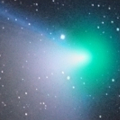
|
It approached to Earth down to 0.29 a.u. in early February, and it brightened up to 4.5 mag (Feb. 1, Juan Jose Gonzalez). Now it is fading. It has already faded down to 10.1 mag (Mar. 10, Osamu Miyazaki). In the Northern Hemisphere, it stays observable until mid April. In the Southern Hemisphere, it stays observable in good condition after this.
Date(TT) R.A. (2000) Decl. Delta r Elong. m1 Best Time(A, h)
Mar. 11 4 41.15 -3 0.5 1.236 1.437 79 9.0 19:50 (126, 44)
Mar. 18 4 44.29 -4 58.5 1.439 1.507 73 9.6 19:39 (120, 43)
|
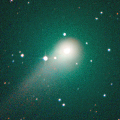
|
Now it is 10.6 mag (Mar. 10, Osamu Miyazaki). It stays bright as 10 mag for a long time until autumn. In the Northern Hemisphere, it becomes unobservable temporarily in early April. But it becomes observable again in summer. In the Southern Hemipshere, it stays unobservable until summer.
Date(TT) R.A. (2000) Decl. Delta r Elong. m1 Best Time(A, h)
Mar. 11 1 53.71 38 9.7 2.754 2.327 54 9.9 19:50 (128,-12)
Mar. 18 1 59.22 35 56.6 2.848 2.306 48 9.9 19:39 (125,-13)
|
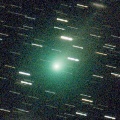
|
It brightened very rapidly. Now it is very bright as 9.9 mag (Feb. 28, Osamu Miyazaki). It stays 9-10 mag until March. In the Northern Hemisphere, it stays observable for a long time. But it locates low until spring. In the Southern Hemisphere, it is not observable until June.
Date(TT) R.A. (2000) Decl. Delta r Elong. m1 Best Time(A, h)
Mar. 11 23 0.18 48 35.9 2.167 1.756 52 10.1 4:29 (232,-38)
Mar. 18 23 19.04 46 49.7 2.267 1.773 48 10.3 4:36 (233,-35)
|

|
Now it is 12.1 mag (Feb. 8, T. Prystavski). It is expected to brighten up to 10 mag from spring to summer. In the Southern Hemisphere, it stays observable in good condition for a long time. In the Northern Hemisphere, it is not observable until 2024 autumn.
Date(TT) R.A. (2000) Decl. Delta r Elong. m1 Best Time(A, h)
Mar. 11 19 44.43 -38 20.4 3.500 3.127 60 11.2 4:29 (293, 42)
Mar. 18 19 52.66 -40 10.9 3.387 3.115 65 11.1 4:36 (294, 47)
|
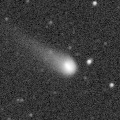
|
Now it is 11.4 mag (Feb. 25, Jose Guilherme de S. Aguiar). It stays 12 mag until summer. It stays observable in good condition for a long time.
Date(TT) R.A. (2000) Decl. Delta r Elong. m1 Best Time(A, h)
Mar. 11 12 36.22 -0 46.5 2.675 3.628 160 11.8 1:25 (180, 56)
Mar. 18 12 21.36 -1 4.5 2.639 3.626 171 11.8 0:43 (180, 56)
|

|
It brightened up to 8.3 mag in last winter (Jan. 6, 2022, Toshiyuki Takahashi). Now it is fading. But it is bright as 11.7 mag still now (Mar. 1, Giuseppe Pappa). It is observable in excellent condition in the Southern Hemisphere. It locates low in the Northern Hemisphere.
Date(TT) R.A. (2000) Decl. Delta r Elong. m1 Best Time(A, h)
Mar. 11 9 11.52 -34 54.0 4.460 5.159 130 12.0 21:56 (180, 90)
Mar. 18 9 8.11 -34 34.1 4.527 5.201 128 12.1 21:25 (180, 90)
|
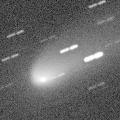
|
Now it is 12.0 mag (Feb. 27, Osamu Miyazaki). It stays 12 mag until spring.
Date(TT) R.A. (2000) Decl. Delta r Elong. m1 Best Time(A, h)
Mar. 11 17 12.38 -19 2.8 1.486 1.803 91 12.2 4:29 (238, 64)
Mar. 18 17 23.12 -19 3.8 1.448 1.834 95 12.2 4:36 (228, 68)
|
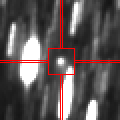
|
Now it is 13.7 mag (Feb. 26, F. Kugel, J. Nicolas). It will brighten very rapidly. It is expected to be observable at 11 mag in excellent condition from spring to summer.
Date(TT) R.A. (2000) Decl. Delta r Elong. m1 Best Time(A, h)
Mar. 11 18 9.58 -23 46.0 2.022 2.053 77 13.0 4:29 (261, 56)
Mar. 18 18 23.99 -22 58.5 1.938 2.040 81 12.7 4:36 (255, 60)
|
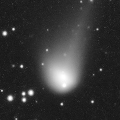
|
Now it is bright as 12.5 mag (Mar. 1, Giuseppe Pappa). It stays 13 mag until spring. It stays observable in good condition for a while after this.
Date(TT) R.A. (2000) Decl. Delta r Elong. m1 Best Time(A, h)
Mar. 11 15 44.26 8 56.1 4.306 4.809 114 12.9 4:29 (181, 46)
Mar. 18 15 44.77 10 15.8 4.253 4.836 120 13.0 4:05 (180, 45)
|
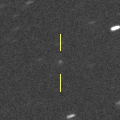
|
Now it is 14.8 mag (Feb. 28, H. Sato). The condition is bad in this apparition. Appearing in the morning sky in the Southern Hemisphere. It is not observable until May in the Northern Hemisphere.
Date(TT) R.A. (2000) Decl. Delta r Elong. m1 Best Time(A, h)
Mar. 11 21 19.60 -21 21.4 2.371 1.651 34 13.1 4:29 (285, 16)
Mar. 18 21 39.54 -20 8.6 2.359 1.670 36 13.2 4:36 (282, 19)
|
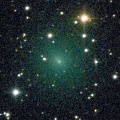
|
It brightened very rapidly up to 9.6 mag in late January (Jan. 25, Toshihiko Ikemura, Hirohisa Sato). Now it is fading. It has already faded down to 12.8 mag (Mar. 3, Ken-ichi Kadota). It stays observable in good condition for a long time.
Date(TT) R.A. (2000) Decl. Delta r Elong. m1 Best Time(A, h)
Mar. 11 6 18.18 7 34.8 0.980 1.558 104 13.3 19:50 (164, 46)
Mar. 18 6 30.40 3 45.4 1.098 1.612 100 13.9 19:39 (160, 50)
|
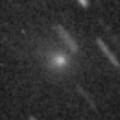
|
Bright new comet. Now it is 13.2 mag (Mar. 2, Giuseppe Pappa). In the Southern Hemisphere, it stays observable in good condition after this. In the Northern Hemisphere, it is not observable after this.
Date(TT) R.A. (2000) Decl. Delta r Elong. m1 Best Time(A, h)
Mar. 11 20 59.40 -34 23.3 1.772 1.279 44 13.3 4:29 (295, 26)
Mar. 18 21 18.44 -38 49.7 1.747 1.358 50 13.5 4:36 (298, 31)
|

|
Now it is 13.7 mag (Feb. 27, Hiroshi Abe). The brightness evolution is slower than originally predicted. It stays 14 mag until summer. In the Northern Hemisphere, it will too low to observe in late March. In the Southern Hemisphere, it stays observable in good condition for a long time.
Date(TT) R.A. (2000) Decl. Delta r Elong. m1 Best Time(A, h)
Mar. 11 3 32.72 -17 37.7 2.387 2.122 62 13.7 19:50 ( 96, 40)
Mar. 18 3 39.52 -18 26.0 2.427 2.099 59 13.7 19:39 ( 94, 39)
|
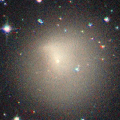
|
It brightened in major outburst in late November. Now it is still bright as 11.6 mag (Feb. 16, Toshihiko Ikemura, Hirohisa Sato).
Date(TT) R.A. (2000) Decl. Delta r Elong. m1 Best Time(A, h)
Mar. 11 6 17.04 28 16.6 5.764 6.079 103 13.7 19:50 (169, 26)
Mar. 18 6 18.08 28 6.6 5.876 6.081 97 13.7 19:39 (165, 25)
|
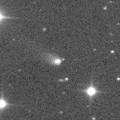
|
It brightened up to 14.5 mag in February (Feb. 16, Ken-ichi Kadota). It is expected to brighten up to 8 mag in July. Now it is not observable. In the Southern Hemisphere, it will appear in the morning sky at 13 mag in mid April, and it will be observable in excellent condition at the high light. In the Northern Hemisphere, it is not observable until June, and it becomes very low at the high lihght.
Date(TT) R.A. (2000) Decl. Delta r Elong. m1 Best Time(A, h)
Mar. 11 0 24.99 -11 37.5 3.348 2.417 17 14.0 19:50 ( 75, -1)
Mar. 18 0 26.75 -11 22.0 3.303 2.349 13 13.8 19:39 ( 73, -4)
|
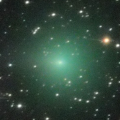
|
It brightened up to 9.7 mag in autumn (Oct. 23, Marco Goiato). Now it is fading. It has already faded down to 15.3 mag (Mar. 2, G. Duszanowicz, J. Camarasa). In the Southern Hemisphere, it stays observable in good condition for a long time. It locates low in the Northern Hemisphere.
Date(TT) R.A. (2000) Decl. Delta r Elong. m1 Best Time(A, h)
Mar. 11 19 3.44 -41 10.3 2.201 2.057 68 14.1 4:29 (294, 50)
Mar. 18 18 53.27 -42 3.6 2.097 2.111 77 14.3 4:36 (295, 59)
|
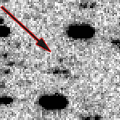
|
It approached to Sun down to 0.1 a.u. on Jan. 31. Appearing in the morning sky. It was bright as 7.0-7.5 mag in early February (Feb. 5, Michael Jager). Now it is fading rapidly. It has already faded down to 13.5 mag (Mar. 3, Giuseppe Pappa). It stays observable after this while the comet will be fading.
Date(TT) R.A. (2000) Decl. Delta r Elong. m1 Best Time(A, h)
Mar. 11 20 16.99 -7 31.4 1.523 1.103 46 14.1 4:29 (264, 21)
Mar. 18 20 18.99 -7 48.8 1.555 1.235 52 14.8 4:36 (259, 28)
|
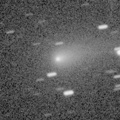
|
Now it is 13.3 mag (Feb. 15, Toshihiko Ikemura, Hirohisa Sato). It will be fading after this. It stays observable in good condition for a while.
Date(TT) R.A. (2000) Decl. Delta r Elong. m1 Best Time(A, h)
Mar. 11 8 26.08 19 56.7 1.215 2.036 134 14.2 21:12 (180, 35)
Mar. 18 8 29.84 20 27.6 1.294 2.061 127 14.4 20:48 (180, 35)
|
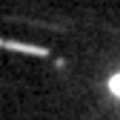
|
Now it is 15.0 mag (Mar. 3, Ken-ichi Kadota). It will brighten rapidly up to 14 mag and will be observable in excellent condition in spring. In the Northern Hemisphere, it was observable in good condition in winter, but it becomes somewhat low in spring.
Date(TT) R.A. (2000) Decl. Delta r Elong. m1 Best Time(A, h)
Mar. 11 14 35.60 -21 6.1 1.624 2.354 126 14.3 3:24 (180, 76)
Mar. 18 14 34.05 -22 40.3 1.556 2.351 133 14.2 2:55 (180, 78)
|
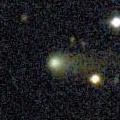
|
Now it is 14.6 mag (Feb. 15, Toshihiko Ikemura, Hirohisa Sato). It stays 14.5 mag and observable in good condition until spring.
Date(TT) R.A. (2000) Decl. Delta r Elong. m1 Best Time(A, h)
Mar. 11 9 21.34 28 39.1 2.542 3.381 142 14.5 22:06 (180, 26)
Mar. 18 9 21.06 29 2.3 2.607 3.387 135 14.6 21:39 (180, 26)
|
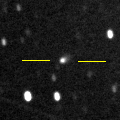
|
Now it is 14.4 mag (Mar. 3, Ken-ichi Kadota). It is expected to brighten up to 7 mag in early 2024. In the Southern Hemisphere, it stays observable in good condition for a long time. It locates low in the Northern Hemisphere.
Date(TT) R.A. (2000) Decl. Delta r Elong. m1 Best Time(A, h)
Mar. 11 5 13.93 -32 45.4 4.378 4.421 85 14.7 19:50 ( 88, 67)
Mar. 18 5 15.53 -31 47.5 4.372 4.353 82 14.6 19:39 ( 88, 64)
|
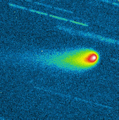
|
Now it is 14.1 mag (Feb. 15, Toshihiko Ikemura, Hirohisa Sato). It stays 14 mag in 2023. In the Southern Hemisphere, it stays observable in good condition for a long time, although it becomes unobservable temporarily from April to May. It locates somewhat low in the Northern Hemisphere.
Date(TT) R.A. (2000) Decl. Delta r Elong. m1 Best Time(A, h)
Mar. 11 2 34.63 -8 10.0 3.900 3.317 47 14.7 19:50 ( 96, 23)
Mar. 18 2 33.85 -6 55.8 3.980 3.303 41 14.7 19:39 ( 95, 19)
|
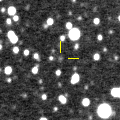
|
Now it is 15.3 mag (Mar. 5, ATLAS Chile). It will brighten up to 13 mag from 2024 to 2025. It is observable in excllent condition in the Southern Hemisphere. It locates low in the Northern Hemisphere.
Date(TT) R.A. (2000) Decl. Delta r Elong. m1 Best Time(A, h)
Mar. 11 8 46.67 -37 38.2 5.847 6.465 124 15.2 21:31 ( 0, 87)
Mar. 18 8 45.15 -36 58.9 5.838 6.434 122 15.2 21:02 ( 0, 88)
|
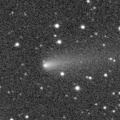
|
It continued brightening even after the perihelion passage. It was bright as 14.7 mag still in February (Feb. 16, Toshihiko Ikemura, Hirohisa Sato). However, now it is 16.3 mag (Mar. 6, ATLAS-HKO, Haleakala). It will be fading after this, and it will be fainter than 18 mag in July. It is observable in good condition in the Northern Hemisphere. It locates somewhat low in the Southern Hemisphere.
Date(TT) R.A. (2000) Decl. Delta r Elong. m1 Best Time(A, h)
Mar. 11 7 28.03 25 49.1 2.095 2.729 119 15.4 20:14 (180, 29)
Mar. 18 7 31.05 25 48.3 2.199 2.752 113 15.5 19:49 (180, 29)
|

|
Now it is 14.8 mag (Dec. 8, ATLAS Chile). Now it is not observable. It will become observable again in late March in the Southern Hemisphere, or in late May in the Northern Hemisphere.
Date(TT) R.A. (2000) Decl. Delta r Elong. m1 Best Time(A, h)
Mar. 11 22 38.03 -15 53.9 4.209 3.267 16 15.4 4:29 (291, -2)
Mar. 18 22 47.88 -14 58.5 4.194 3.279 20 15.4 4:36 (287, 2)
|

|
It brightened up to 13.4 mag in last summer (July 7, Giuseppe Pappa). Now it is fading. It has already faded down to 15.5 mag (Mar. 3, Ken-ichi Kadota). It stays 15-16 mag until summer. It stays observable in good condition for a while.
Date(TT) R.A. (2000) Decl. Delta r Elong. m1 Best Time(A, h)
Mar. 11 18 9.17 4 18.2 3.480 3.428 78 15.4 4:29 (229, 38)
Mar. 18 18 7.97 6 36.2 3.399 3.462 85 15.4 4:36 (218, 41)
|
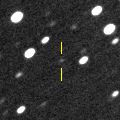
|
Now it is 15.2 mag (Mar. 1, ATLAS South Africa). It is expected to brighten up to 12-13 mag from 2024 to 2025.
Date(TT) R.A. (2000) Decl. Delta r Elong. m1 Best Time(A, h)
Mar. 11 9 26.58 -13 37.7 5.119 5.970 146 15.4 22:11 (180, 69)
Mar. 18 9 20.73 -12 27.3 5.122 5.927 140 15.4 21:38 (180, 67)
|
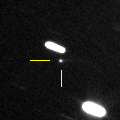
|
Now it is 16.1 mag (Mar. 6, Catalina Sky Survey). It will brighten very rapidly up to 11.5 mag in April. In the Southern Hemisphere, it stays observable in good condition for a long time. In the Northern Hemisphere, it is not observable from mid April to mid June.
Date(TT) R.A. (2000) Decl. Delta r Elong. m1 Best Time(A, h)
Mar. 11 14 9.92 25 35.7 0.347 1.261 134 16.1 2:57 (180, 30)
Mar. 18 14 40.95 28 4.1 0.269 1.188 130 15.5 3:00 (180, 27)
|
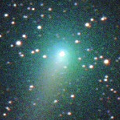
|
It brightened up to 9.3 mag in early summer in 2022 (June 5, Chris Wyatt). Now it is fading. It has already faded down to 15.7 mag (Feb. 15, Toshihiko Ikemura, Hirohisa Sato). In the Southen Hemisphere, it stays observable in good condition for a long time. It locates somewhat low in the Northern Hemisphere.
Date(TT) R.A. (2000) Decl. Delta r Elong. m1 Best Time(A, h)
Mar. 11 6 44.79 -18 43.6 3.238 3.669 107 15.7 19:50 (164, 73)
Mar. 18 6 42.46 -16 18.7 3.386 3.732 102 15.9 19:39 (153, 69)
|
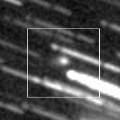
|
Now it is 16.2 mag (Feb. 21, Toshihiko Ikemura, Hirohisa Sato). It is expected to brighten up to 11.5 mag in 2024 spring. It stays observable in good condition for a long time. At the high light, it will be observable in excellent condition in the Southern Hemisphere, but it will be low in the Northern Hemisphere.
Date(TT) R.A. (2000) Decl. Delta r Elong. m1 Best Time(A, h)
Mar. 11 18 37.36 16 34.3 4.708 4.525 73 15.9 4:29 (227, 24)
Mar. 18 18 36.84 17 9.3 4.560 4.474 78 15.8 4:36 (219, 28)
|

|
Now it is 17.5 mag (Mar. 5, E. Cortes, M. Kumrucu-Lohmiller, B. Lutkenhoner, N. Paul). It will approach to Sun down to 0.8 a.u. in April, and it will brighten up to 15 mag. In the Southern Hemisphere, it stays observable in the extremely low sky. In the Northern Hemisphere, it is not observable after March.
Date(TT) R.A. (2000) Decl. Delta r Elong. m1 Best Time(A, h)
Mar. 11 20 54.41 -17 7.6 1.509 0.960 38 16.5 4:29 (278, 19)
Mar. 18 21 32.14 -14 54.7 1.499 0.912 36 16.0 4:36 (276, 17)
|
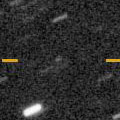
|
Now it is 17.9 mag (Feb. 26, Toshihiko Ikemura, Hirohisa Sato). It stays observable at 14-15 mag from spring to autumn. It locates somewhat low in the Northern Hemisphere.
Date(TT) R.A. (2000) Decl. Delta r Elong. m1 Best Time(A, h)
Mar. 11 17 59.30 -13 55.9 3.109 3.098 80 16.2 4:29 (245, 52)
Mar. 18 18 6.42 -14 14.3 2.999 3.081 85 16.1 4:36 (237, 58)
|

|
It will brighten rapidly up to 13.5 mag in summer. In the Southern Hemisphere, it stays observable until August. In the Northern Hemisphere, it is not observable until June. But it stays observable in good condition after that.
Date(TT) R.A. (2000) Decl. Delta r Elong. m1 Best Time(A, h)
Mar. 11 22 26.20 -40 24.3 2.797 2.113 38 16.3 4:29 (309, 14)
Mar. 18 22 43.12 -38 2.2 2.738 2.072 39 16.1 4:36 (305, 16)
|
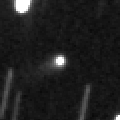
|
Now it is 15.6 mag (Feb. 17, Toshihiko Ikemura, Hirohisa Sato). It stays observable at 16 mag for a long time from early 2023 to early 2024. In the Northern Hemisphere, it is observable only until 2023 spring.
Date(TT) R.A. (2000) Decl. Delta r Elong. m1 Best Time(A, h)
Mar. 11 8 55.63 -6 31.5 3.284 4.111 141 16.2 21:40 (180, 62)
Mar. 18 8 47.56 -6 53.3 3.328 4.085 134 16.2 21:04 (180, 62)
|
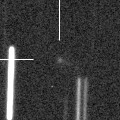
|
Now it is 16.5 mag (Feb. 23, Ken-ichi Kadota). It will brighten up to 13 mag in summer. In the Northern Hemisphere, it stays observable in good condition for a long time. In the Southern Hemisphere, it is not observable until August.
Date(TT) R.A. (2000) Decl. Delta r Elong. m1 Best Time(A, h)
Mar. 11 3 1.63 73 58.7 1.846 2.014 84 16.4 19:50 (164,-26)
Mar. 18 2 41.42 71 34.7 1.897 1.949 77 16.3 19:39 (160,-27)
|

|
It was observed at 15 mag from 2021 to 2022. Now it is fading. Now it is 16.3 mag (Feb. 11, J.-C. Merlin, D. De Martin). In the Southern Hemisphere, it stays observable in excellent condition for a long time. In the Northern Hemiphere, it is not observable after this.
Date(TT) R.A. (2000) Decl. Delta r Elong. m1 Best Time(A, h)
Mar. 11 14 38.59 -71 25.6 6.006 6.225 98 16.3 3:28 ( 0, 54)
Mar. 18 14 22.90 -72 21.4 5.966 6.256 102 16.3 2:45 ( 0, 53)
|
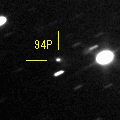
|
Now it is 16.6 mag (Feb. 21, ATLAS Chile). It is observable at 16.5 mag in good condition in spring. It locates somewhat low in the Southern Hemisphere.
Date(TT) R.A. (2000) Decl. Delta r Elong. m1 Best Time(A, h)
Mar. 11 8 13.11 28 45.2 1.524 2.281 128 16.4 20:59 (180, 26)
Mar. 18 8 14.53 28 28.2 1.578 2.271 122 16.5 20:33 (180, 27)
|
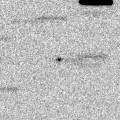
|
Now it is 16.4 mag (Mar. 1, Catalina Sky Survey). It is observable at 16.5 mag in good condition from January to March. It locates somewhat low in the Southern Hemisphere.
Date(TT) R.A. (2000) Decl. Delta r Elong. m1 Best Time(A, h)
Mar. 11 13 36.30 31 11.5 0.402 1.321 138 16.5 2:24 (180, 24)
Mar. 18 13 37.01 30 56.4 0.425 1.351 140 16.6 1:58 (180, 24)
|
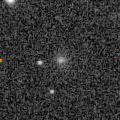
|
Now it is 16.4 mag (Feb. 21, Ken-ichi Kadota). It moves along an almost circular orbit. It seems to be bright temporarily in outburst.
Date(TT) R.A. (2000) Decl. Delta r Elong. m1 Best Time(A, h)
Mar. 11 10 48.51 25 50.5 5.217 6.142 156 16.5 23:33 (180, 29)
Mar. 18 10 45.54 26 2.0 5.252 6.142 150 16.5 23:03 (180, 29)
|

|
Now it is 15.8 mag (Feb. 22, ATLAS South Africa). It was expected to brighten up to 13 mag in 2022 spring. But actually, it was fainter than originally expected. In the Southern Hemisphere, it stays observable in good condition for a long time, although it becomes unobservable temporarily from April to May. In the Northern Hemisphere, it will be unobservable soon.
Date(TT) R.A. (2000) Decl. Delta r Elong. m1 Best Time(A, h)
Mar. 11 2 18.79 -19 26.1 4.653 4.022 45 16.6 19:50 ( 84, 26)
Mar. 18 2 21.34 -17 50.2 4.759 4.062 41 16.6 19:39 ( 83, 22)
|
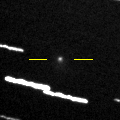
|
Now it is 16.2 mag (Mar. 5, R. Naves, M. Campas). In the Northern Hemisphere, it stays observable at 16.5 mag in excellent condition from February to March. In the Southern Hemisphere, it is not observable until late March.
Date(TT) R.A. (2000) Decl. Delta r Elong. m1 Best Time(A, h)
Mar. 11 8 6.13 61 1.6 1.216 1.837 112 16.6 20:50 (180, -5)
Mar. 18 7 39.25 53 10.4 1.274 1.835 107 16.7 19:56 (180, 2)
|
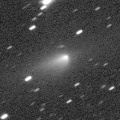
|
It brightened up to 12.7 mag in last year (Feb. 27, 2022, Jose Guilherme de S. Aguiar). Now it is fading. Appearing in the morning sky. In the Southern Hemisphere, it stays observable until summer when it becomes fainter than 18 mag. It locates low in the Northern Hemisphere.
Date(TT) R.A. (2000) Decl. Delta r Elong. m1 Best Time(A, h)
Mar. 11 19 10.38 -25 26.8 2.991 2.707 64 16.7 4:29 (273, 44)
Mar. 18 19 20.18 -25 17.3 2.930 2.732 68 16.7 4:36 (269, 49)
|
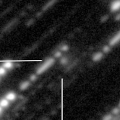
|
Now it is 16.6 mag (Mar. 5, iTelescope Observatory, Siding Spring). It brightens up to 16.5 mag from March to April. In the Southern Hemisphere, it stays observable in excellent condition. In the Northern Hemisphere, it is not observable until the end of March.
Date(TT) R.A. (2000) Decl. Delta r Elong. m1 Best Time(A, h)
Mar. 11 11 38.58 -54 4.4 1.001 1.743 121 16.9 0:27 ( 0, 71)
Mar. 18 11 45.00 -51 40.5 0.955 1.745 127 16.8 0:06 ( 0, 73)
|
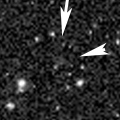
|
Now it is 16.5 mag (Mar. 1, ATLAS Chile). Very far object. It stays 16-17 mag for a long time from 2021 to 2026. In the Southern Hemisphere, it stays observable in good condition for a long time. In the Northern Hemisphere, it is not observable at all.
Date(TT) R.A. (2000) Decl. Delta r Elong. m1 Best Time(A, h)
Mar. 11 5 0.91 -72 35.9 10.446 10.399 84 16.8 19:50 ( 14, 49)
Mar. 18 4 58.07 -71 56.0 10.435 10.394 84 16.8 19:39 ( 16, 49)
|
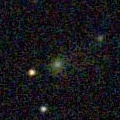
|
It brightened rapidly. Now it is 16.2 mag (Feb. 27, Masayoshi Yoshimi). It will be fading after this. It will be fainter than 18 mag in April.
Date(TT) R.A. (2000) Decl. Delta r Elong. m1 Best Time(A, h)
Mar. 11 9 54.20 22 3.7 1.154 2.084 151 16.9 22:39 (180, 33)
Mar. 18 9 52.80 22 10.4 1.218 2.112 144 17.1 22:10 (180, 33)
|
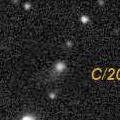
|
Now it is 17.1 mag (Mar. 3, ATLAS Chile). It stays 17 mag and observable in good condition until summer.
Date(TT) R.A. (2000) Decl. Delta r Elong. m1 Best Time(A, h)
Mar. 11 13 12.43 9 34.1 8.035 8.925 152 17.0 2:01 (180, 46)
Mar. 18 13 8.12 10 10.7 8.000 8.932 158 17.0 1:29 (180, 45)
|
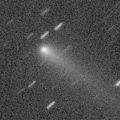
|
It brightened up to 14.1 mag in autumn (Nov. 14, Thomas Lehmann). Now it is fading. It has already faded down to 16.8 mag (Feb. 27, Masayoshi Yoshimi). In the Northern Hemisphere, it stays observable in excellent condition for a while. In the Southern Hemisphere, it will be unobservable soon.
Date(TT) R.A. (2000) Decl. Delta r Elong. m1 Best Time(A, h)
Mar. 11 3 26.92 34 53.5 2.862 2.675 69 17.1 19:50 (138, 4)
Mar. 18 3 39.46 35 32.5 2.964 2.701 65 17.2 19:39 (138, 3)
|
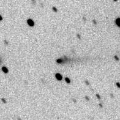
|
Now it is 16.8 mag (Mar. 2, ATLAS Chile). It will be fading and getting lower gradually after this. It will be unobservable in April in the Northern Hemisphere, or in May in the Southern Hemisphere.
Date(TT) R.A. (2000) Decl. Delta r Elong. m1 Best Time(A, h)
Mar. 11 4 24.75 3 28.9 3.657 3.547 75 17.1 19:50 (128, 36)
Mar. 18 4 30.88 4 4.9 3.755 3.554 70 17.1 19:39 (126, 34)
|

|
It has not been observed yet in this apparition. In the last apparition, it had faded before the perihelion passage. If it becomes as bright as its last apparition, it will brighten up to 17 mag. It stays observable in good condition for a long time.
Date(TT) R.A. (2000) Decl. Delta r Elong. m1 Best Time(A, h)
Mar. 11 14 16.18 2 27.1 2.013 2.819 136 17.2 3:04 (180, 53)
Mar. 18 14 15.93 3 11.1 1.944 2.804 143 17.1 2:36 (180, 52)
|
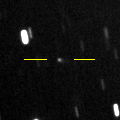
|
Now it is 17.3 mag (Feb. 27, Ken-ichi Kadota). In the Northern Hemisphere, it stays observable at 17 mag in good condition from spring to summer. In the Southern Hemisphere, it locates extremely low only in summer.
Date(TT) R.A. (2000) Decl. Delta r Elong. m1 Best Time(A, h)
Mar. 11 13 17.35 49 33.9 2.532 3.244 128 17.2 2:05 (180, 6)
Mar. 18 13 16.53 51 19.6 2.519 3.214 126 17.1 1:37 (180, 4)
|
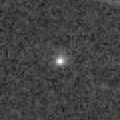
|
It was observed at 17 mag in 2022 autumn. It is observable at 17 mag also in 2023 spring.
Date(TT) R.A. (2000) Decl. Delta r Elong. m1 Best Time(A, h)
Mar. 11 20 33.25 1 6.7 2.312 1.718 42 17.2 4:29 (259, 13)
Mar. 18 20 28.75 2 41.9 2.211 1.747 50 17.1 4:36 (252, 20)
|

|
It brightened very rapidly up to 15.5 mag from last autumn to last winter (Nov. 2, 2021, Toshihiko Ikemura, Hirohisa Sato). Now it is fading slowly. It has already faded down to 16.7 mag (Feb. 17, Toshihiko Ikemura, Hirohisa Sato).
Date(TT) R.A. (2000) Decl. Delta r Elong. m1 Best Time(A, h)
Mar. 11 6 12.48 10 46.8 4.356 4.680 102 17.2 19:50 (163, 43)
Mar. 18 6 14.60 10 59.4 4.480 4.702 96 17.3 19:39 (158, 41)
|
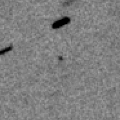
|
Now it is 17.3 mag (Feb. 26, ATLAS-HKO, Haleakala). It stays observable at 17 mag from spring to early summer. It locates low in the Southern Hemisphere.
Date(TT) R.A. (2000) Decl. Delta r Elong. m1 Best Time(A, h)
Mar. 11 9 11.63 38 22.5 1.828 2.622 134 17.3 21:57 (180, 17)
Mar. 18 9 9.58 38 14.0 1.874 2.609 128 17.2 21:27 (180, 17)
|
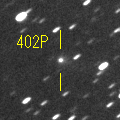
|
It brightened up to 15.3 mag in last winter (Jan. 12, 2022, H. Nohara). Now it is fading. It has already faded down to 17.5 mag (Feb. 27, A. Diepvens). It will be observable at 17 mag in good condition in next winter. It locates low in the Southern Hemisphere.
Date(TT) R.A. (2000) Decl. Delta r Elong. m1 Best Time(A, h)
Mar. 11 9 58.24 30 20.8 3.799 4.664 146 17.3 22:43 (180, 25)
Mar. 18 9 55.43 30 45.2 3.875 4.683 140 17.3 22:13 (180, 24)
|
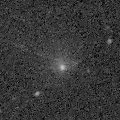
|
Now it is 17.2 mag (Feb. 23, ATLAS South Africa). Very large comet. It is expected to brighten up to 14 mag in 2031. In the Southern Hemisphere, it stays observable in good condition for a long time. In the Northern Hemisphere, it is not observable until 2030.
Date(TT) R.A. (2000) Decl. Delta r Elong. m1 Best Time(A, h)
Mar. 11 2 34.93 -58 9.1 18.287 17.901 65 17.3 19:50 ( 40, 41)
Mar. 18 2 37.10 -57 56.1 18.263 17.876 65 17.3 19:39 ( 40, 39)
|
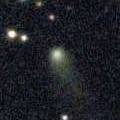
|
Now it is 17.3 mag (Mar. 4, Catalina Sky Survey). Fading slowly. In the Southern Hemisphere, it is not observable after this.
Date(TT) R.A. (2000) Decl. Delta r Elong. m1 Best Time(A, h)
Mar. 11 18 35.67 50 29.6 6.279 6.214 81 17.4 4:29 (206, -4)
Mar. 18 18 40.41 51 45.9 6.290 6.247 82 17.4 4:36 (201, -2)
|

|
Now it is 17.5 mag (Feb. 25, Toshihiko Ikemura, Hirohisa Sato). Fading slowly. In the Northern Hemisphere, it stays observable in good condition for a long time. In the Southern Hemisphere, it is not observable after this.
Date(TT) R.A. (2000) Decl. Delta r Elong. m1 Best Time(A, h)
Mar. 11 18 32.60 71 0.8 9.754 9.774 88 17.4 4:29 (194,-20)
Mar. 18 18 33.37 71 58.7 9.779 9.791 87 17.5 4:36 (191,-20)
|
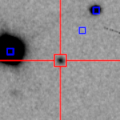
|
It will approach to Sun down to 0.4 a.u. in late September in 2024, and it is expected to brighten up to 0 mag. Now it is 17.1 mag (Mar. 5, P. Matassa). It stays observable in good condition for a while. At the high light, in the Northern Hemisphere, it will be observable in good condition after the perihelion passage. In the Southern Hemisphere, it will be observable in the low sky before and after the perihelion passage.
Date(TT) R.A. (2000) Decl. Delta r Elong. m1 Best Time(A, h)
Mar. 11 15 19.22 -0 37.0 6.611 7.169 120 17.7 4:07 (180, 56)
Mar. 18 15 16.90 -0 15.3 6.453 7.107 127 17.6 3:37 (180, 55)
|
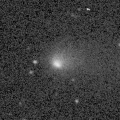
|
It brightened up to 14.6 mag in autumn (Oct. 19, Toshihiko Ikemura, Hirohisa Sato). Now it is fading. It has already faded down to 17.6 mag (Feb. 16, Toshihiko Ikemura, Hirohisa Sato). It will be fainter than 18 mag in spring.
Date(TT) R.A. (2000) Decl. Delta r Elong. m1 Best Time(A, h)
Mar. 11 3 22.10 13 0.2 2.666 2.365 61 17.6 19:50 (122, 19)
Mar. 18 3 34.54 13 54.7 2.760 2.388 58 17.8 19:39 (122, 17)
|
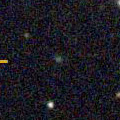
|
Now it is 17.4 mag (Feb. 16, Toshihiko Ikemura, Hirohisa Sato). It stays 17 mag for a long time from 2023 to 2024. It is observable in good condition in the Northern Hemisphere. It locates low in the Southern Hemisphere.
Date(TT) R.A. (2000) Decl. Delta r Elong. m1 Best Time(A, h)
Mar. 11 2 41.68 28 43.1 7.440 6.963 57 17.6 19:50 (127, 1)
Mar. 18 2 46.04 28 58.0 7.517 6.951 52 17.6 19:39 (125, -1)
|
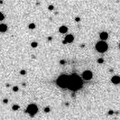
|
Now it is 17.7 mag (Feb. 26, A. Diepvens). It will be fading after this, and it will be fainter than 18 mag in April. It locates somewhat low in the Southern Hemisphere.
Date(TT) R.A. (2000) Decl. Delta r Elong. m1 Best Time(A, h)
Mar. 11 5 53.06 25 43.6 3.672 3.945 98 17.7 19:50 (162, 27)
Mar. 18 5 56.56 25 39.5 3.779 3.948 92 17.8 19:39 (159, 26)
|
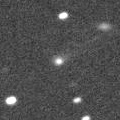
|
It brightened up to 15.9 mag in 2022 spring (May 5, Toshiyuki Takahashi). Now it is 17.5 mag (Mar. 3, ATLAS South Africa). In 2023, it is observable at 17.5 mag in spring.
Date(TT) R.A. (2000) Decl. Delta r Elong. m1 Best Time(A, h)
Mar. 11 16 28.99 -24 6.0 4.588 4.868 100 17.8 4:29 (227, 75)
Mar. 18 16 30.55 -24 15.6 4.488 4.875 107 17.7 4:36 (198, 79)
|
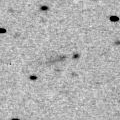
|
Now it is 18.2 mag (Feb. 27, Ken-ichi Kadota). It stays observable at 18 mag in good condition from January to March. It looks elongated.
Date(TT) R.A. (2000) Decl. Delta r Elong. m1 Best Time(A, h)
Mar. 11 10 12.92 15 34.9 3.242 4.186 159 17.8 22:58 (180, 40)
Mar. 18 10 10.16 15 54.2 3.280 4.184 151 17.8 22:27 (180, 39)
|
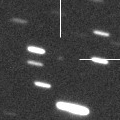
|
Now it is 18 mag (Feb. 11, Giuseppe Pappa). It stays 17.5 mag until spring. It is observable in good condition in the Northern Hemisphere. It is not observable in the Southern Hemisphere.
Date(TT) R.A. (2000) Decl. Delta r Elong. m1 Best Time(A, h)
Mar. 11 4 14.16 73 40.0 2.976 3.123 89 17.8 19:50 (168,-22)
Mar. 18 4 44.11 71 30.8 3.028 3.124 86 17.9 19:39 (168,-20)
|
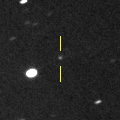
|
Now it is 17.9 mag (Feb. 19, Purple Mountain Observatory, XuYi Station). It will brighten up to 15 mag from 2024 to 2025. In 2023, it is observable at 18 mag in spring.
Date(TT) R.A. (2000) Decl. Delta r Elong. m1 Best Time(A, h)
Mar. 11 9 36.57 26 16.6 3.496 4.357 146 17.9 22:21 (180, 29)
Mar. 18 9 32.99 26 22.1 3.546 4.345 138 17.9 21:50 (180, 29)
|
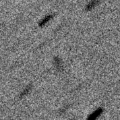
|
Now it is 17.9 mag (Feb. 20, H. Nohara). It will be fading after this, and it will be fainter than 18 mag in March. It locates somewhat low in the Southern Hemisphere.
Date(TT) R.A. (2000) Decl. Delta r Elong. m1 Best Time(A, h)
Mar. 11 11 49.25 27 21.9 1.601 2.540 155 17.9 0:38 (180, 28)
Mar. 18 11 44.47 28 15.4 1.631 2.558 152 18.0 0:06 (180, 27)
|

|
Now it is 17.3 mag (Feb. 26, Ken-ichi Kadota). It will be fainter than 18 mag soon.
Date(TT) R.A. (2000) Decl. Delta r Elong. m1 Best Time(A, h)
Mar. 11 8 35.43 1 33.0 2.711 3.514 138 17.9 21:20 (180, 53)
Mar. 18 8 35.05 1 58.4 2.778 3.519 131 18.0 20:53 (180, 53)
|
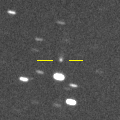
|
It was predicted to brighten up to 16 mag in 2023. But actually, it is very faint as 18.1 mag (Feb. 16, iTelescope Observatory, Siding Spring). In the Southern Hemisphere, it stays observable in good condition for a long time. In the Northern Hemisphere, it will never be observable again.
Date(TT) R.A. (2000) Decl. Delta r Elong. m1 Best Time(A, h)
Mar. 11 18 28.97 -73 38.7 3.248 3.253 81 18.0 4:29 (344, 46)
Mar. 18 18 55.68 -74 11.9 3.205 3.259 84 18.0 4:36 (345, 46)
|
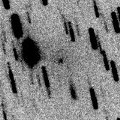
|
Tiny comet, but it approached to Sun down to 0.8 a.u. in January, and it will approach to Earth down to 0.6 a.u. in March. It was expected to brighten up to 14 mag from January to March. But actually, it became disintegrated before the perihelion passage. Now it is extremely faint as 18.2 mag (Feb. 20, Thomas Lehmann). In the Southern Hemisphere, it stays observable in good condition for a long time. It becomes observable in good condition after this also in the Northern Hemisphere.
Date(TT) R.A. (2000) Decl. Delta r Elong. m1 Best Time(A, h)
Mar. 11 5 59.85 -31 56.8 0.601 1.211 95 18.9 19:50 (103, 76)
Mar. 18 6 39.42 -16 10.4 0.654 1.299 101 19.3 19:39 (153, 68)
|
|
![]()
 199P/Shoemaker 4
199P/Shoemaker 4 126P/IRAS
126P/IRAS C/2022 A3 ( Lemmon-ATLAS )
C/2022 A3 ( Lemmon-ATLAS ) C/2022 W3 ( Leonard )
C/2022 W3 ( Leonard ) C/2018 U1 ( Lemmon )
C/2018 U1 ( Lemmon ) 94P/Russell 4
94P/Russell 4 263P/Gibbs
263P/Gibbs P/2023 B1 ( PanSTARRS )
P/2023 B1 ( PanSTARRS ) C/2020 Y2 ( ATLAS )
C/2020 Y2 ( ATLAS ) C/2023 A1 ( Leonard )
C/2023 A1 ( Leonard ) 116P/Wild 4
116P/Wild 4 C/2023 B2 ( ATLAS )
C/2023 B2 ( ATLAS ) C/2019 E3 ( ATLAS )
C/2019 E3 ( ATLAS ) 204P/LINEAR-NEAT
204P/LINEAR-NEAT C/2020 F2 ( ATLAS )
C/2020 F2 ( ATLAS ) P/2022 L3 ( ATLAS )
P/2022 L3 ( ATLAS ) 408P/2020 M7 ( Novichonok-Gerke )
408P/2020 M7 ( Novichonok-Gerke ) 280P/Larsen
280P/Larsen C/2022 U4 ( Bok )
C/2022 U4 ( Bok ) C/2022 Q2 ( ATLAS )
C/2022 Q2 ( ATLAS ) P/2021 N2 ( Fuls )
P/2021 N2 ( Fuls ) 180P/NEAT
180P/NEAT 402P/2020 Q3 ( LINEAR )
402P/2020 Q3 ( LINEAR ) C/2014 UN271 ( Bernardinelli-Bernstein )
C/2014 UN271 ( Bernardinelli-Bernstein ) C/2020 H6 ( ATLAS )
C/2020 H6 ( ATLAS ) C/2019 O3 ( Palomar )
C/2019 O3 ( Palomar ) C/2023 A3 ( Tsuchinshan-ATLAS )
C/2023 A3 ( Tsuchinshan-ATLAS ) 61P/Shajn-Schaldach
61P/Shajn-Schaldach C/2021 S4 ( Tsuchinshan )
C/2021 S4 ( Tsuchinshan ) 244P/Scotti
244P/Scotti 99P/Kowal 1
99P/Kowal 1 452P/2022 B5 ( Sheppard-Jewitt )
452P/2022 B5 ( Sheppard-Jewitt ) C/2022 W2 ( ATLAS )
C/2022 W2 ( ATLAS ) 65P/Gunn
65P/Gunn 211P/Hill
211P/Hill P/2021 V2 ( Fuls )
P/2021 V2 ( Fuls ) C/2021 C5 ( PanSTARRS )
C/2021 C5 ( PanSTARRS ) C/2022 S3 ( PanSTARRS )
C/2022 S3 ( PanSTARRS )![]()


































































